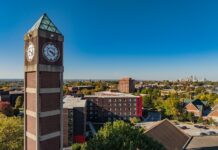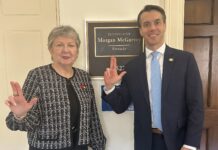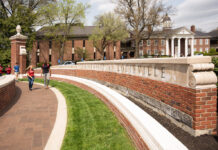Specifically, AHEC faculty from UofL provided donated services valued at $5.6 million while their students spent a total of $108,103 in living and travel expenses in the four regions. These regions encompass 56 counties that make up the western half of Kentucky. The University of Kentucky Medical Center oversees AHEC programs in eastern Kentucky.
The AHEC program works to improve the recruitment, distribution and retention of health care professionals, particularly in primary care, in medically underserved areas throughout the commonwealth.
“The AHEC program demonstrates on multiple levels how UofL is working with local communities to improve the lives of the people within the commonwealth,” said UofL President James Ramsey. “We partner with local organizations to provide the people necessary to meet today’s health care needs of underserved areas, while training future health care providers so they remain in these areas. At the same time, the financial impact of these partnerships cannot be underestimated.”
“We believe the economic impact in each county we serve is an extra benefit in the return on the investment into the AHEC program,” said V. Faye Jones, AHEC program director and assistant dean of academic affairs at UofL’s School of Medicine. “The primary benefit of the program is found in the services and activities AHEC provides; the corresponding dollar value of these services gives us another way to measure the full scope of the good work AHEC is doing for the people of Kentucky.”
Statewide, 108 of Kentucky’s 120 counties are designated as federal Health Professional Shortage Areas by the U.S. Department of Health and Human Services. Kentucky’s AHEC program addresses this need by providing educational support services to current health profession students and health care providers; health education programs for communities; and programs that encourage students to pursue health professions as a career choice.
Collaborations are key to the success of the program.
“Our partnerships with the community-based organizations and health care professionals in our four regions define the focus of our AHEC programs,” Jones said. “Each regional office works with the people in that region to develop culturally appropriate programs that address the needs of that region.”
For example, the Purchase AHEC, based in Murray, works to “grow its own” health professionals with the Rural Community Health Scholars Program, a four-week summer program that introduces undergraduates from the region to the need for health and medical professionals in rural communities like their own. The South Central AHEC region, based in Bowling Green, led efforts to create the Glasgow-Barren County Family Medicine Residency Program to encourage family medicine physicians to remain and practice in the area after their residency is completed.
The Northwest AHEC is located in Louisville and uses a variety of activities to introduce K-12 students to health profession careers. The West AHEC is based in Madisonville and partners with the UofL School of Dentistry and the Henderson County Community College Dental Assisting/Hygiene program in operating the Henderson Children’s Free Dental Clinic to address poor oral health for Kentucky’s children.
Throughout all regions, more than 1,300 UofL Health Sciences Center students in 11 disciplines complete clinical rotations at AHEC centers. These medical, nursing, dental, allied health and other health profession students experience practical, hands-on training in clinics, private offices and community hospitals in the AHEC regions.
UofL also provides physicians, dentists, nurses and other health professionals who practice throughout the AHEC regions with continuing education programs and support services. The Kentucky AHEC Library Network links these professionals to the medical information resources available at UofL, providing them access to textbook collections, reference works, medical journals and online computer resources.
Kentucky AHEC’s funding comes primarily from Kentucky General Assembly appropriations. It also receives funding from the Health Resources Service Administration of HHS, UofL and UK, and from matching and in-kind funding from a variety of national, regional and local organizations.





























